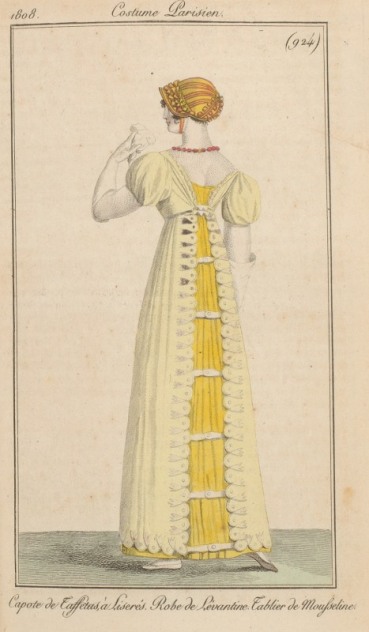The Ceinture à la Victime
References in French fashion to the Revolution’s victims are not exactly unknown – in fact, they’ve achieved an almost mythological status. They seem to be thought of as a flash-in-the-pan pertaining only to the Directoire era (1795-1799) and its uncertainty, but in actuality, they lost the connection to the guillotine and continued to be worn once society had become more stable.
The earliest appearance in a fashion plate that I’m aware of is the above, from Journal des Dames et des Modes in 1797. Variations, such as the “croisures à la victime” below (1797), appeared soon after. Both styles feature a bright, contrasting ribbon crossed over the back, wrapped around the shoulders, and tied at the waist.
I don’t find the references to the Terror’s victims after 1797, but ribbon belts or sashes worn crossed over the back and around the waist continued to be depicted in fashion plates for about twenty years afterward. Ribbon color and pattern were very important to fashion during this period – one dress could last a wearer several years without appearing démodé, updated economically every so often with a few yards of ribbon.
Fashions in trimming bonnets could also show the importance of fashionable ribbons on a plain background. Note that in this plate, the ceinture is so commonplace as to be included on a torso marked as displaying a colerette and pelerine.
The Tablier-Robe
Unlike the ceinture à la victime, the tablier-robe (or robe-apron, although it does not turn up much in the English fashion press) seems to be completely unknown, but it also appears in a huge number of fashion plates. Always fastening in the back, it is sometimes shown with ribbons holding the skirts together or simply open down to the hem, sometimes buttoning in the bodice or tied at neckline and waist.
It begins to appear in France around 1804, at the same time that gowns were transitioning to a back closure, and it continues to appear in fashion plates for more than a decade. There’s little to say about the tablier-robe‘s evolution – ties all the way down tend to be earlier, but apart from that they tend to be a little fantastic and not follow a progression the way gowns do.
The only extant apron-robe that I’m aware of appears in Costume in Detail (p. 101): “white spotted muslin dress, very high waist, very low neckline.” It has a tie at the back of the neck and four buttonholes (no buttons remaining), and the skirt is open the entire way down the back. This identification isn’t definite, but it seems a lot more likely to me that it was intended to be worn over another gown than that it stood on its own.







Leave a comment